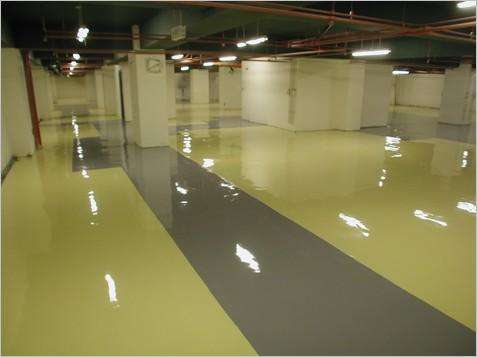Self Leveling epoxy floors: 5 frequently asked questions
Self-leveling (or self-smoothing) floors are probably the most common type of epoxy floors out there. Here's a list of frequently asked questions about these types of floors below.
1.Why are they called self-leveling floors?
The floors are referred to as self leveling since upon application the epoxy resin coating forms a smooth and level texture on the surface of the floor. (unlike applying the coating with a roller or squeegee where you may get a slightly rougher orange-peel texture)
2.What makes them so popular?
These floors have major operational advantages for industries. The smooth and seamless surface makes them ideal for the movement of forklift trucks and other vehicles that are shifting heavy loads on a continuous basis. Also the seamless structure makes the floors easier for cleaning and does not allow the accumulation of dirt and bacteria.
Self-leveling epoxy floors also provide a very aesthetic appeal since the glossy seamless look makes the space look bigger and far more attractive. (see picture above). This why architects love them and often specify them for commercial and retail spaces.
3.What is the minimum required thickness to achieve a self-leveling floor?
My rule is that you should go for a minimum thickness of 2mm (1/16 inches). Any epoxy product under that thickness you are bound to run intoleveling problems such as trowel marks, roller marks, dents and other funny looking shapes on the floor. Keep in mind that depending on the substrate you may have thicknesses of 1mm in some places and 4mm (especially in the corners) in other areas of the floor.
4.I have a somewhat rough and uneven cement substrate. Can't I just pour some self-leveling epoxy to even it out?
No you shouldn’t, as this is not the purpose of self-leveling epoxy. The surface unevenness of the substrate will be likely much larger than the 2-3 mm thickness of your floor coating. You run the risk of adding large amounts of epoxy (at a significant cost!) and not getting any substantial results as the unevenness of the surface will remain. Therefore you should only apply the product on flat and level surfaces.
If you need to even out the surface before you apply the epoxy, you could look into using self leveling cementitious compound. Other solutions could be grinding the substrate or using epoxy grout to fill the substrate unevenness.
5.Why are self-leveling floors so much more expensive than roller applied epoxy systems?
The amount of epoxy consumed in self leveling systems is several times higher than in a roller (or squeegee) applied systems. A two-coat roller applied epoxy system may consume 500-600 gr/m2 whereas a 3mm self leveling system can easily reach 3 kg/m2 of epoxy. Furthermore self-leveling epoxy is usually more expensive than standard epoxy paint since the product needs to be formulated differently. Another very important factor is that for such systems you need to use qualified and trained workers who have experience in self-leveling epoxy systems. So you should expect a much higher cost of labour.

 Chinese
Chinese English
English





